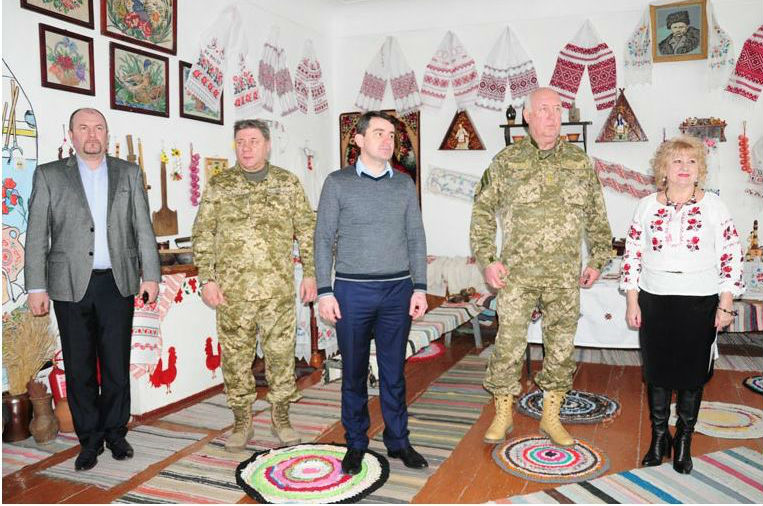 The fast train travels the nearly 700 kilometers from Kyiv to Slovyansk in just under six hours. It stops a few times before arriving at the train station in the suburbs of Slovyansk, the small city of 125,000 that Moscow’s agents seized and held for nearly three months shortly after its hybrid war in Ukraine’s east began in early April of 2014. Slovyansk was the westernmost point of the Kremlin’s offensive.
The fast train travels the nearly 700 kilometers from Kyiv to Slovyansk in just under six hours. It stops a few times before arriving at the train station in the suburbs of Slovyansk, the small city of 125,000 that Moscow’s agents seized and held for nearly three months shortly after its hybrid war in Ukraine’s east began in early April of 2014. Slovyansk was the westernmost point of the Kremlin’s offensive.
I recently visited Slovyansk to give a lecture on the advantages of an open society at a local library which hosts a Window on America center. My trip was arranged by the International Research and Exchanges Board (IREX). Yuliya Tkachuk, the resourceful deputy of IREX’s Kyiv office, arranged and joined the trip.
As we drive into the city, we see no destruction or signs that this was once a war zone. Local officials explain that there was no fighting when the Moscow-backed separatists seized the city, nor when they left. Once the advancing Ukrainian forces cut Slovyansk’s supply lines in early July of 2014, the separatists slipped away at night. The officials said that life in the city was much better than elsewhere in the occupied areas because it became a center for journalists, and the occupation authorities wanted to demonstrate the benefits of life under the their regime. Our hosts said that it was something of a pokazukha, the Russian word for a showplace meant to convey a reality that is not in fact true.
Of course, the occupiers did not treat well local officials of the Ukrainian government, such as the then-mayor of the city, Nelya Shtepa, whom they arrested and compelled to make statements in support of the occupation. In addition, at the start of the occupation, some of the irregular forces began to harass the general population, as was common elsewhere in the occupied zone.
But then Igor Girkin (also known as Strelkov) arrived from Crimea and was quickly named “Minister of Defense” of the Donetsk People’s Republic. Girkin promised a delegation of local businessmen that the harassment would stop; and it did, we were told. He also promised them that no private property would be taken, but that Ukrainian state property was fair game. The locals who met him described Girkin as charismatic, calm, low key, and decisive.
As Ukrainian forces approached Slovyansk in early July of 2014, the city lost its showplace function. In their last couple of days in town, Moscow’s surrogates shot up a number of large buildings and destroyed several hundred private homes, wholly or in part.
Those homes remain largely unrepaired. Local officials complain that there is no help from Kyiv either for repairs or to deal with the influx of internally displaced people from the occupied territories. They say there are approximately 40,000 who either now live in the Slovyansk area or come to Slovyansk from the occupied territories to collect pensions and other Ukrainian social benefits. Slovyansk social services are taking care of these people without additional resources from Kyiv.
Local officials claim that the current government in Kyiv is incompetent. The Yanukovych regime, in contrast, was efficient, albeit the level of corruption large by even Ukrainian standards.
Nearly all of our Slovyansk interlocutors note that before Moscow launched its war, the area was largely pro-Russian and deeply skeptical, if not hostile, to the Maidan Revolution and the then-new authorities in Kyiv. Today, while skepticism toward Kyiv remains, the attitude toward Moscow is much colder overall. The overwhelming desire is for peace and calm.
This is evident in the case of Nelya Shtepa, who after the occupation was arrested by Ukrainian authorities on the grounds that she collaborated with the occupiers. The newly elected mayor of Slovyansk, Vadim Lyakh, used her as a symbol while running for that office last fall. He put up posters exhorting voters to “love Slovyansk like Nelya Shtepa.” For the minority in Slovyansk who consider her a collaborator, this slogan was seen as a call for people to betray Ukraine. But a majority of voters recalled her fondly as a good manager and were happy to support the candidate who stood up for her.
Since the election, this potentially divisive issue has not resurfaced in the city. Her supporters and her detractors prefer quiet. Lyakh belongs to the Opposition Bloc, the successor to the Party of the Regions and the most popular party in the area. But some local officeholders belong to Samopomich and the President’s party.
In the aftermath of the occupation, Slovyansk is much less the insular enclave looking northeast to Moscow than it once was.
John E. Herbst is Director of the Atlantic Council’s Dinu Patriciu Eurasia Center. He served as US Ambassador to Ukraine from 2003 to 2006.
Image: On March 11, 2016, Slovyansk Mayor Vadim Lyakh (center) took part in the opening of a memorial plaque in a secondary school. Credit: Слов’янська міська рада

